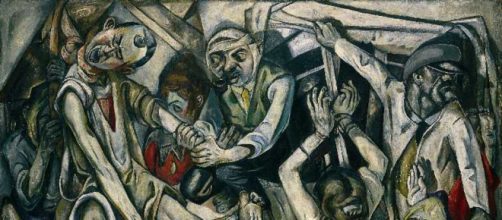Interpreting art is personal. It only becomes disputable when the reading of a work wanders so far into private places that it passes into irrelevancy.
Say what?
Consider the wandering of Jonathan Jones, art critic for The Guardian who sees a scene of terror as a wild, fun-seeking party.
Credit goes to Cornelie Usborne, professor emerita of history at London’s University of Roehampton, for being the first to notice Jones’ incomprehensible take on Max Beckmann’s painting "Die Nacht" (The Night).
The painting describes a figure with a rope around his neck getting strung up for hanging.
Also in the scene are three assailants, a woman bound to a post, and a small child being taken away. The image looks to be a vision of powerlessness and vulnerability.
What does Jones say? At first, he acknowledges that Beckmann was “a painter infected by war” – a reference to the artist’s nervous breakdown after serving as a medical corpsman in WWI.
Looking through rose-colored glasses
But then Jones proceeds to question his assumption about war affecting Beckmann’s work when it comes to "The Night" and asks, “Is this a scene of oppression or delight?”
Jones thinks the man being hanged “might even have agreed to this suffering, which makes the painting an image of sex and nocturnal adventure.”
Can it be that Jones is suggesting erotic asphyxiation – starving the brain of oxygen to intensify orgasm?
“It is obvious,” he said, “that nothing is what it seems in 'The Night.' This is a place where pain and pleasure, torture and desire, are impossible to separate.”
Where’s the party?
If it’s a party, Professor Usborne sees it as a “party from hell, with bondage.” If anything, she sees it as an “allegorical depiction of the tragedy of war and revolution.”
"The Night" appears that way to me, too – a scene of horror rather than an orgy. Calling the painting a wild party is like saying Edvard Munch’s "The Scream" shows a figure yawning. Or like the RNC describing the January 6 mob at the U.S. Capitol “legitimate political discourse.”
There’s a ton of anecdotal evidence indicating the impact of the war-affected Beckmann even after he left Germany for the U.S.
In Peter Selz’s 1964 bio of the painter, he noted that despite being free, he couldn’t shake his fears.
Selz observed that when Beckmann spotted a policeman, “panic seized him” remembering the police state in Germany. “Max Beckmann left the scene with haste, filled with nervous anxiety.”
But wait, no one should need artists’ bios to interpret their work. Visual art needs to stand without a libretto. Beckmann was classed as an Expressionist for good reason. His feelings are plain to see.
In an exhibit of his work in London in 1938, he said, “I want to show in my work the idea which hides behind so-called reality.” It’s hard to think his idea behind "The Night" is a bacchanal.
Interpreting art is personal. But surely there’s such a thing as abusing the privilege.


